Apparently, concrete doesn’t cure as well in colder weather as it does when it’s warmer. From what I’ve read, it’s not ideal to pour standard concrete in “cold weather,” which is defined as three consecutive days with lows and highs in the 40-50 degrees F range. And my understanding is that freezing weather is not good for the setting of new concrete. So, I’ve been trying to beat Winter in building our concrete piers for the foundation of our house.
Well, even though things started to cool down with the weather quite a bit, I learned there are some things you can do to allow you to go ahead and pour anyway, if the temperatures aren’t too low. You can add more cement, and you can warm the concrete mixture (I suppose this is more applicable if you’re having concrete delivered). You can also attempt to keep the poured concrete warm with blankets, and even heaters, if necessary.
And so, for the last several piers, I covered or wrapped them in blankets in the evening after the pour. For the upper part of the pier, I would let the piece of board holding the bolt in place remain there for two days before removing it (whereas before I was only keeping it there for one day). And then, if the sun came out, I would uncover the concrete to let the sunshine in:
Throughout building these piers, I had no trouble with the concrete tubes. On the second to the last pier, after finishing the top part and setting the bolt in place, I was cleaning up; and I turned around, and the concrete had sunk probably 3/4″ down. I wondered what was happening; and when I looked, the bottom of the tube had cracked open, and the concrete was pushing out. Oh no. I didn’t know what to do. Should I pull the concrete tube and try to salvage the concrete, quickly cut another tube, and put the concrete back? But I figured that was going to be difficult to even physically accomplish, and the whole area would be difficult to reset with the amount of concrete used (the tube was nearly 3′ tall), among other potential problems. And so, I ran and got the duct tape and taped around the break to try to “stop the bleeding.” I had to pull the pier back up to being level too and reset the wood bracing form to hold it upright. And then, I just put more concrete on top. It sank some more, and I had to add concrete again; but after that, things seemed to set. And it appears to have worked ok. Thanks to the Lord for granting that!
And with that pier done, it was on to the last pier. Here it is!
And here’s me prepping it for cold weather:
This is me reading it a bedtime story from its favorite book, after tucking it in for the night:
After 38 piers, using 312 1/2 bags of concrete, all mixed with water by hand, the piers for the pier and beam foundation of our house are finished!
This is a view from the north:
And this is from the east:
We thank the Lord for granting us the provisions and strength to work on the house.
— David
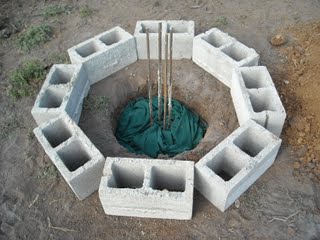
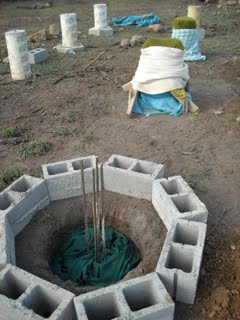
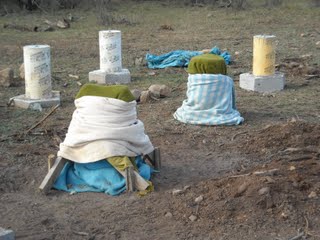
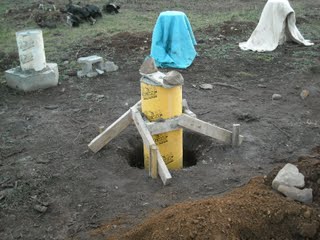
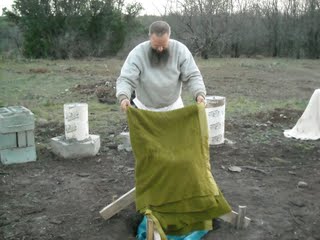
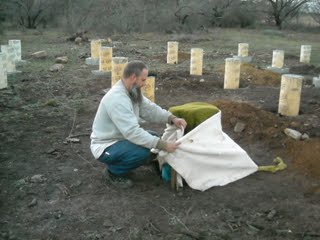
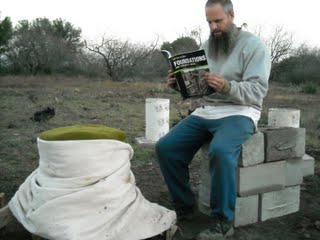
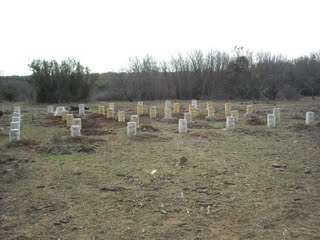
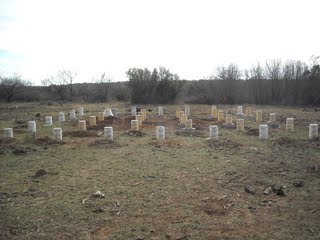
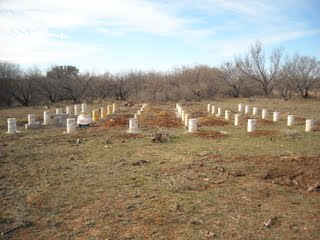
Youse guys are hilarious! Methinks you wanted to read that book for yourself! The concrete pier already knows that story.
LOL!
So, how big will your house be? It looks pretty big from what I can see. I used to think that I wanted a tiny house, because it would be easier to clean and all, but then I thought about needing to store my canning stuff, sewing stuff, gardening stuff, cooking stuff, herbal stuff, animal stuff, etc., etc., etc. If you are going to be self-sufficient in any way, you need space.
Keep up the good work. YHWH bless you.
Hi Ginny,
The plan is for a 40'x40', with half the house being a combo kitchen/dining room, to allow Sue to have the room she needs to do her jobs in there, and to allow hopefully enough space for when folks come over. Sue's been very patient with the very minimal room in her kitchen in the camper, so I'm hoping to give her plenty of space in the house.
Thanks, Ginny,
— David
Thanks for sharing all the photos and the "story" of finishing the house piers. (Your book reading comment/picture brought the immediate outloud comment from me with a giggle…"you guys are so goofy and can find humour in anything!" Thanks for the uplift! Praise God the form crack problem was resolvable quickly! Given the bedrock layer; I'd think the foundation piers to be one of the most challenging in your building process overall. Keeping you in prayer as you proceed to the framing/building of your home.
What other rooms are planned in the layout? Nice kitchen/dining dimensions! Can never have too much food prep. room and storage, that's for sure. God bless your endeavors!
Beth
Thanks much, Beth.
The other half of the house is planned to be about half bedroom and half library, although the closet space of the bedroom is planned to take from the library space. Between the bedroom and kitchen is planned the bathroom and pantry areas (separated from each other back to back). And I think there might be planned some closet space between the dining room and library, but I can't remember off the top.
Thanks again,
— David
I asked my chemist friend about the surfactant and this is what he said.
Wes said that it works only in water. If you add a surfactant to the pig oil, it will elevate the pour point, and will not affect the viscosity.
You might add up to 25% non aromatic 140 N solvent and may work. We don't have any of this in stock….
DO NOT add over 25% of this solvent to your oil
You may be able to get this at a local oil company such as where you purchase kerosene.
debbieo
(The comment from debbieo references the following blog post: http://www.siffordsojournal.com/2009/05/homemade-fat-lamp.html)
Hi debbieo,
Thanks for looking into that info. I appreciate it.
— David
I can't tell from your photos. What size diameter tube did you use for the piers?
Hi Vern,
They were the 12 inch tubes. I actually discuss more about the piers in this update: http://blog.siffordsojournal.com/2009/08/house-update-ii-foundation.html. The way I did them with rebar into the ground, someone in the comments on that update said something about concrete cancer and the piers crumbling in 5 years, but pros here that did other concrete work for us put rebar into the ground, and we haven't had issue yet with the house piers, and it's been nearly 7 years now.
Anyway, HTH,
— David
Awesome! Thanks David. I just found your site today and am really enjoying it. We are about to begin construction of our home so I am looking for all sorts of info. 🙂 We live just to due east of you about 4 hours drive, so I think the winter weather here would be about the same as you experienced.
My blog/newspaper column is http://AccordingToVern.com if you are interested.
Blessings brother,
Vern
Hi Vern,
Nice to meet you, and I hope it all goes well for you! On an aside, one thing I think I might do differently with the pier beams is probably use 5 layers instead of the 3 we did. I'm a little worried that over the years 3 might not be enough, but I guess we'll have to see. I have thought of attaching 1/2 inch plywood on each side beams across the spans, and maybe someday might do that.
Anyway again, although I appreciate the link to your site, I usually don't publish comments with links in them, and just for disclaimer purposes, me publishing this comment does not vouch for the site, but I thought I would go ahead because it does look like you have some interesting homestead sustainability things there.
Thanks for saying hello!
— David
Thanks David. Feel free to delete that link. If I had your email I was trying to send it to you directly. Not trying to ride your site for clicks to mine. Just wanted to introduce myself to ya. 😉
Blessings,
Vern
Hi Vern,
No worries. Didn't really think that was your intention. 🙂
If you want, you can comment your email address, and I just won't publish it.
— David